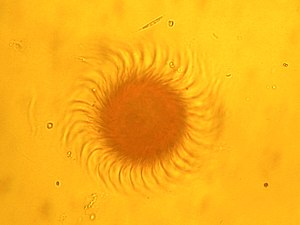Mallomonas
| Mallomonas | ||||||||||||
|---|---|---|---|---|---|---|---|---|---|---|---|---|

Mallomonas |
||||||||||||
| Systematics | ||||||||||||
|
||||||||||||
| Scientific name | ||||||||||||
| Mallomonas | ||||||||||||
| Perty |
Mallomonas is occurring in freshwater algae - genus from the group of Stramenopilen . It consists of around 130 species.
features
The single-cell genus from the Chrysomonadea class (Engler, 1898) is between 5 and 20 micrometers in size. There are flagella at the front end of the cell pole. The longer flagellum takes on the tasks of locomotion and attachment to a substrate. At the scourge there are mastigonemen. The second flagellum is very much reduced. Discobolocysts occur as extrusomes, while extrusomes are membrane organelles that can be quickly evolved and which are usually used for defense. These protists have a nucleus and 1–2 pulsating vacuoles. The polysaccharide chrysolaminarin and some lipids are stored in the vacuoles as reserve substances. Mallomonas has two large, sickle-shaped, gold-yellow to gold-brownish chloroplasts. The chloroplasts contain chlorophyll a, c and fucoxanthin. There is no chlorophyll b in Mallomonas. A reddish eye spot can often be seen on one of the chloroplasts, this stigma serves to perceive light. The way of generating energy can be adapted to the respective ecological requirements, it is possible to switch to a heterotrophic way of life.
The cell surface is covered by brick-like scales. The scales consist of silicon dioxide ("silica"), have complex, highly ordered structures and are arranged like a honeycomb. The cell can actively leave its housing.
Species of the genus Mallomonas can live free-swimming or attach themselves to the substrate. Representatives of this genus can also form groups. Sexual processes take place through the fusion of single cells without having formed haploid gametes. After the amalgamation (isogamy) the zygote encysts itself. Permanent cysts can also be formed in an asexual way.
Occurrence
The representatives of the genus occur especially in spring in the plankton of clean, cold, mostly acidic standing waters.
supporting documents
- Karl-Heinz Linne von Berg, Michael Melkonian u. a .: The Kosmos algae guide. The most important freshwater algae under the microscope. Kosmos, Stuttgart 2004, ISBN 3-440-09719-6 , p. 80.